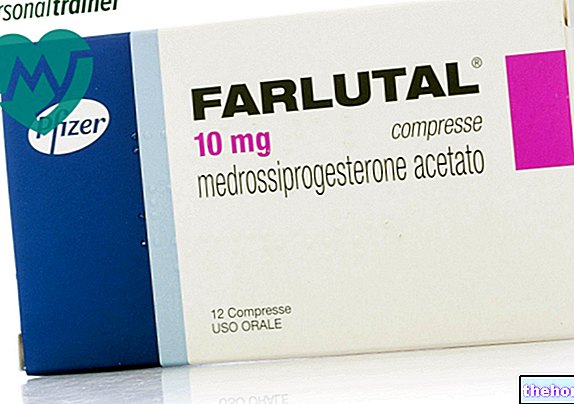Active ingredients: Limecycline
TETRALYSAL 150 mg hard capsules
TETRALYSAL 300 mg hard capsules
Why is Tetralysal used? What is it for?
Tetralysal belongs to a group of antibiotic drugs called tetracyclines. The primary use of Tetralysal is to treat moderate to severe acne. Acne appears as an inflammation of the skin that presents with papules (small raised lesions of the skin without pus), pustules (small lesions of the skin that contain pus), blackheads and pimples.
Contraindications When Tetralysal should not be used
Do not take Tetralysal
- If you are allergic to tetracycline-L-methylenesine (limecycline) or any of the other ingredients of this medicine (listed in section 6);
- Tetralysal is contraindicated in pregnancy and lactation (see section "Special warnings")
- Tetralysal is contraindicated in children under 8 years of age due to the risk of permanent changes in tooth and enamel color. Teralysal is contraindicated in treatment together with oral retinoids (vitamin A products taken by mouth)
Precautions for use What you need to know before taking Tetralysal
Talk to your doctor or pharmacist before taking Tetralysal. As with other antibiotics, treatment with tetracyclines can cause secondary bacterial or fungal (fungal) infections. In particular, there is the possibility of resistant staphylococcal enterocolitis (inflammation of the small intestine and colon due to bacteria that resist the therapeutic action of the drug).
If you are undergoing prolonged courses of treatment with Tetralysal, your doctor will prescribe periodic checks of your blood composition and liver and kidney function.
In susceptible people, skin reactions may occur during treatment after exposure to sunlight and tanning lamps. If redness of the skin (skin rash) occurs, the treatment must be stopped immediately.
If you have kidney failure, tell your doctor before taking Tetralysal and carefully follow the instructions given to you.
Take the medicine with an adequate amount of water to avoid irritation to the esophagus.
Children
Tetralysal should not be used in children under 8 years of age due to the risk of permanent discolouration of the teeth and enamel.
Interactions Which drugs or foods can modify the effect of Tetralysal
Tell your doctor or pharmacist if you are taking, have recently taken or might take any other medicines.
- Do not use Tetralysal together with vitamin A products by mouth due to the risk of increased pressure in the skull.
- Do not take antacids containing aluminum, calcium or magnesium and products containing iron salts or didanosine together with Tetralysal, as these products reduce the absorption of tetracyclines taken by mouth.
- Avoid use with penicillins (another type of antibiotic), due to the possible interference between the two medicines.
- If you are being treated with anticoagulant medicines (medicines to prevent blood clots from forming), please tell your doctor as your dosage may need to be adjusted due to the possible reduction in activity caused by tetracyclines.
- Limecycline (active ingredient contained in Tetralysal) can cause false positives in the determination of glucose in urine.
Warnings It is important to know that:
Pregnancy and breastfeeding
If you are pregnant or breast-feeding, think you may be pregnant or are planning to have a baby, ask your doctor or pharmacist for advice before using this medicine.
The use of tetracyclines during the period of tooth formation (second half of pregnancy) can cause a permanent yellow-brown discoloration of the baby's teeth, this occurs especially in the case of prolonged use, but has also been observed after periods of short and repeated treatment For this reason do not take Tetralysal if you are pregnant or breastfeeding.
Dose, Method and Time of Administration How to use Tetralysal: Posology
Always take this medicine exactly as your doctor or pharmacist has told you. If in doubt, consult your doctor or pharmacist.
The recommended dose for acne treatment is 300 mg / day for 12 weeks.
You must take the product with an adequate amount of water.
Use in children
Tetralysal should not be used in children under 8 years of age due to the risk of permanent changes in the color of the teeth and enamel
Overdose What to do if you have taken too much Tetralysal
If you have accidentally taken too much Tetralysal you should tell your doctor immediately or go to the nearest hospital.
If you have any further questions on the use of this medicine, ask your doctor or pharmacist.
Side Effects What are the side effects of Tetralysal
Like all medicines, this medicine can cause side effects, although not everybody gets them.
Side effects with common frequency (in 1 in 100 patients, but less than 1 in 10 patients)
- Headache
- Nausea
- Abdominal pain
- Diarrhea
Undesirable effects with frequency not known
- Enterocolitis (inflammation of the small intestine and colon)
- Glossitis (inflammation of the tongue)
- Visual disturbances
- Neutropenia (decrease in neutrophils, a type of white blood cell)
- Thrombocytopenia (decrease in platelets)
- He retched
- Upper gastrointestinal (stomach) pain
- Fever
- Jaundice (yellowing of the skin)
- Hepatitis (inflammation of the liver)
- Hypersensitivity
- Urticaria
- Angioneurotic edema (swelling of the eyelids, lips, tongue, genitals)
- Anaphylactic reaction (severe allergic reaction that occurs quickly and can cause death)
- Increase in transaminases (enzymes in the blood that indicate possible liver damage)
- Increase in alkaline phosphatase (enzymes in the blood that indicate certain diseases)
- Increased bilirubin (substance contained in bile)
- Dizziness
- Intracranial hypertension (increased pressure in the skull)
- Erythematous rash (appearance of skin redness)
- Photosensitivity reactions during exposure to sunlight or tanning lamps
- Itching
- Stevens Johnson syndrome (severe acute hypersensitivity reaction affecting the skin and mucous membranes)
Furthermore
- In case of administration to children under the age of 8, permanent changes in the color of the teeth and changes in the enamel may occur.
- There have been reports of haemolytic anemia (low hemoglobin concentration), eosinophilia (increase in particular blood cells) and other blood disorders;
- There may be cases of increased azotemia (increased amount of nitrogen in the blood) of non-renal origin due to the simultaneous use of diuretics (medicines used to increase urine secretion) and tetracyclines;
- Treatment with Tetralysal should be discontinued if symptoms attributable to increased pressure in the skull (eg vomiting) appear.
- Isolated cases of anorexia (lack or reduction of appetite) and allergic vasculitis (inflammation of the blood vessels) have been reported.
Compliance with the instructions contained in the package leaflet reduces the risk of undesirable effects.
Reporting of side effects
If you get any side effects, talk to your doctor or pharmacist. This includes any possible side effects not listed in this leaflet. Undesirable effects can also be reported directly through the national reporting system at http://www.agenziafarmaco.gov.it/it/responsabili.
By reporting side effects you can help provide more information on the safety of this medicine.
Expiry and Retention
Keep this medicine out of the sight and reach of children.
Do not use this medicine after the expiry date which is stated on the package. The expiry date refers to the last day of that month. The expiry date indicated refers to the product in intact packaging, correctly stored.
Keep this medicine in its original package
Do not store above 25 ° C.
Do not throw any medicines via wastewater or household waste. Ask your pharmacist how to throw away medicines you no longer use. This will help protect the environment.
Composition and pharmaceutical form
What Tetralysal contains
Each 150 mg capsule contains:
The active ingredient is tetracycline-L-methylene lysine (limecycline) equivalent to 150 mg of tetracycline base.
The other ingredients are:
Magnesium stearate, levilite, gelatin, glyceryl monoleate.
Each 300 mg capsule contains:
The active ingredient is tetracycline-L-methylenlysine (limecycline) equivalent to 300 mg of tetracycline base.
The other ingredients are:
Magnesium stearate, hydrated colloidal silica.
Components of the gelatin capsule: gelatin, titanium dioxide (E171), quinoline yellow (E104), erythrosine (E127), indigo carmine (E132).
Description of what Tetralysal looks like and contents of the pack
Hard capsules of 150 mg
Glass bottle containing 28 capsules.
Hard capsules of 300 mg
Al / PE blister of 4 capsules. Packs of 16 or 28 capsules.
Source Package Leaflet: AIFA (Italian Medicines Agency). Content published in January 2016. The information present may not be up-to-date.
To have access to the most up-to-date version, it is advisable to access the AIFA (Italian Medicines Agency) website. Disclaimer and useful information.
01.0 NAME OF THE MEDICINAL PRODUCT
TETRALYSAL HARD CAPSULES
02.0 QUALITATIVE AND QUANTITATIVE COMPOSITION
Each 150 mg capsule contains:
Tetracycline-L-methylenlysine (limecycline) equivalent to 150 mg of tetracycline base.
Each 300 mg capsule contains:
Tetracycline-L-methylenlysine (limecycline) equivalent to 300 mg of tetracycline base.
For the full list of excipients, see 6.1.
03.0 PHARMACEUTICAL FORM
Hard capsules.
04.0 CLINICAL INFORMATION
04.1 Therapeutic indications
Treatment of moderate to severe inflammatory acne.
Treatment of inflammation in mixed acne.
04.2 Posology and method of administration
The recommended dose for acne treatment is 300 mg / day for 12 weeks.
Take the product with an adequate amount of water.
04.3 Contraindications
Hypersensitivity to tetracyclines or to any of the excipients.
During pregnancy and lactation (see 4.6).
Children younger than 8 years of age due to the risk of developing permanent dental discoloration and enamel hypoplasia.
Concomitant treatment with oral retinoids (see 4.5)
04.4 Special warnings and appropriate precautions for use
Reactions of photosensitivity, which are evidenced by an exaggerated skin reactivity to sunlight and ultraviolet rays, can occur during treatment in predisposed subjects; it is advisable to keep this possibility in mind and stop treatment as soon as skin erythema appears.
In patients with renal insufficiency, even normal doses of tetracyclines can lead to accumulation in the circulation with possible liver damage; in these cases it is necessary to adapt the dosage to the degree of liver function. It should also be borne in mind that tetracyclines, due to their known antianabolic action, can increase azotemia and therefore further aggravate a pre-existing state of renal insufficiency.
To avoid esophageal irritation, take the product with an adequate amount of water.
As with other antibiotics, treatment with tetracyclines can result in superinfections with resistant bacterial agents or fungi. In particular, the possibility of resistant staphylococcal enterocolitis should be borne in mind.
Long-term treatment cycles require periodic checks of blood count and liver and kidney function.
04.5 Interactions with other medicinal products and other forms of interaction
- Oral retinoids: risk of intracranial hypertension.
- Antacid preparations containing aluminum, calcium or magnesium, and products containing iron salts, reduce the oral absorption of tetracyclines, so it is necessary to avoid simultaneous intake.
- It is advisable to avoid the association with penicillins, due to the possible appearance of interferences between the respective antibacterial activities.
- It may be necessary to adjust the dosages of anticoagulants that may be used during the administration of tetracyclines, since these antibiotics can depress the prothrombin activity.
- Interference with laboratory tests: limecycline can cause false positives in the determination of glucose in urine. It can also interfere with the fluorometric assay of urinary catecholamines giving rise to falsely increased values (Hingert method).
- Didanosine: the increase in gastric pH following the intake of didanosine tablets containing antacids, reduces the absorption of cyclins in the digestive tract.
04.6 Pregnancy and breastfeeding
In the bone tissue in the process of formation, tetracyclines can give rise to a stable calcium complex without any particular harmful effects being reported in humans.
The use of tetracyclines during the period of tooth formation (second half of pregnancy) can cause permanent tooth pigmentation (yellow-brown); the problem occurs mainly following the prolonged use of these antibiotics, but it has also been observed after short and repeated treatment periods.
Tetracyclines pass both through the placenta and into breast milk.
Therefore, Tetralysal is contraindicated in pregnant or lactating women (risk of enamel hypoplasia or dental discoloration in childhood, see 4.3).
04.7 Effects on ability to drive and use machines
None known.
04.8 Undesirable effects
In case of onset of any undesirable effect, which is not among those reported, the patient is required to inform his doctor or pharmacist during treatment.
In addition, some adverse events attributable, in general, to tetracycline therapy were observed:
- dental discoloration and / or enamel hypoplasia may occur when administered to children under the age of 8;
- cases of haemolytic anemia, eosinophilia and other haematological disorders have been reported;
- cases of azotemia of non-renal origin related to an effect may occur
anti-anabolic which can be increased by the concomitant use of diuretics and tetracyclines;
- treatment with Tetralysal should be discontinued if symptoms attributable to an increase in intracranial pressure (eg vomiting) appear.
Isolated cases of anorexia and allergic vasculitis have been reported.
Reporting of suspected adverse reactions
Reporting of suspected adverse reactions occurring after authorization of the medicinal product is important as it allows continuous monitoring of the benefit / risk balance of the medicinal product. Healthcare professionals are asked to report any suspected adverse reactions via the national reporting system. "address https://www.aifa.gov.it/content/segnalazioni-reazioni-avverse.
04.9 Overdose
Overdose with antibiotics is rare; if this happens, gastric lavage should be considered.
05.0 PHARMACOLOGICAL PROPERTIES
05.1 Pharmacodynamic properties
Pharmacotherapeutic group: antibacterials for systemic use.
ATC code: J01AA04.
Limecycline is an antibiotic belonging to the tetracycline family (group of semi-synthetic cyclins).
Antibacterial activity: the Propionibacterium Acnes is a species sensitive to limecycline.
Effects on acne: the mechanisms by which tetracyclines reduce injuries resulting from "acne vulgaris they have not yet been fully clarified; however, the effect appears to be partly due to the drug's antibacterial activity. Following oral administration, the drug inhibits the growth of sensitive organisms (mainly the Propionibacterium acnes) on the skin surface and reduces the concentration of free fatty acids in the sebum. The reduction of free fatty acids in the sebum could be the indirect result of the inhibition of the organisms that produce lipase which convert triglycerides into free fatty acids or, it could be the direct result of interference in the production of lipase by these organisms. .
Free fatty acids are comedogenic and are believed to be one of the possible causes of inflammatory lesions, such as papules, pustules, nodules and acne cysts. However, other mechanisms appear to be involved as the clinical improvement ofacne vulgaris, following oral treatment with tetracyclines, it may not necessarily correspond to a reduction in the bacterial flora of the skin or a decrease in the content of free fatty acids in the sebum.
05.2 Pharmacokinetic properties
Absorption:
Absorption of limecycline is rapid, effective plasma levels are achieved within one hour of administration. The plasma peak is reached within 3 - 4 hours after oral administration. The simultaneous intake of food, for example milk, does not significantly change the absorption of limecycline.
Distribution:
Oral administration of 300 mg in adults leads to:
- a plasma peak of 1.6 to 4 mcg / mL
- a highly variable residual concentration (from 0.29 to 2.19 mcg / mL)
- a plasma half-life of approximately 10 hours.
Repeated administration results in a mean plasma concentration between 2.3 and 5.8 mcg / mL.
The wide intra- and extra-cellular diffusion, under normal dosage conditions, can lead to actual concentrations in numerous tissues and body fluids and specifically in the lungs, bones, muscles, liver, bladder, prostate, bile and urine.
Excretion / elimination: The product is excreted mainly in the urine and secondarily in the bile. Approximately 65% of the administered dose is eliminated within 48 hours.
05.3 Preclinical safety data
No specific information is reported given the considerable experience achieved in the use of tetracyclines in humans during the last 40 years.
06.0 PHARMACEUTICAL INFORMATION
06.1 Excipients
Hard capsules of 150 mg:
Magnesium stearate, levilite, gelatin, glyceryl monoleate.
Hard capsules of 300 mg:
Magnesium stearate, hydrated colloidal silica.
Components of the gelatin capsule: gelatin, titanium dioxide (E171), quinoline yellow (E104), erythrosine (E127), indigo carmine (E132).
06.2 Incompatibility
Not relevant.
06.3 Period of validity
Hard capsules of 150 mg:
18 months.
Hard capsules of 300 mg:
18 months.
06.4 Special precautions for storage
Store in the original packaging.
Store at a temperature not exceeding 25 ° C.
06.5 Nature of the immediate packaging and contents of the package
Hard capsules of 150 mg
Glass bottle containing 28 capsules.
Hard capsules of 300 mg
Al / PE blisters of 4 capsules.
Packs of 16 or 28 capsules.
06.6 Instructions for use and handling
No special instructions.
07.0 MARKETING AUTHORIZATION HOLDER
GALDERMA Italia S.p.A. - registered office Via dell "Annunciata 21 - Milan
08.0 MARKETING AUTHORIZATION NUMBER
TETRALYSAL 150 mg hard capsules - 28 capsules AIC n. 018469039
TETRALYSAL 300 mg hard capsules - 16 capsules AIC n. 018469054
TETRALYSAL 300 mg hard capsules - 28 capsules AIC n. 018469066
09.0 DATE OF FIRST AUTHORIZATION OR RENEWAL OF THE AUTHORIZATION
TETRALYSAL 150 mg hard capsules: January 1961 / June 2010
TETRALYSAL 300 mg hard capsules: June 2007 / June 2010
10.0 DATE OF REVISION OF THE TEXT
11/2014























-nelle-carni-di-maiale.jpg)




